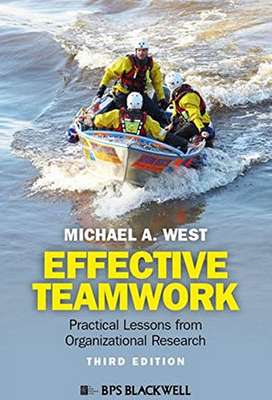Effective Teamwork: Practical Lessons from Organizational Research
6.390 kr.

Námskeið
- VIÐ182F Starf stjórnandans, forysta og samskipti
Annað
- Höfundur: Michael A. West
- Útgáfa:3
- Útgáfudagur: 2012-01-20
- Hægt að prenta út 10 bls.
- Hægt að afrita 2 bls.
- Format:ePub
- ISBN 13: 9781118871935
- Print ISBN: 9780470974971
- ISBN 10: 1118871936
Efnisyfirlit
- Front Matter
- Contents
- Acknowledgements
- Part 1 Team Effectiveness
- 1 Creating Effective Teams
- Key Learning Points
- Task and Social Elements of Team Functioning
- Team Effectiveness
- Table 1 Four types of teams and their outcomes.
- Exercise 1 The team reflexivity questionnaire
- Key Revision Points
- Further Reading
- Web Resources
- 2 Real Teams Work
- Key Learning Points
- Case Study
- why work in Teams?
- Barriers to Effective Teamwork
- Loss of effort
- Poor problem solving and decision making
- Box 1 Baseball or basketball teams?
- Low creativity
- Baseball or basketball teams?
- What is a Team?
- What do Teams do?
- How can we build Effective Teams?
- Exercise 2 Measuring the effectiveness of your team’s performance
- Conclusions
- Case Study
- Key Revision Points
- Further Reading
- Web Resources
- 1 Creating Effective Teams
- 3 Creating Teams
- Key Learning Points
- Personality and Ability
- Box 2 Belbin’s team role theory
- Teamwork Skills
- Social skills
- Knowledge, skills and attitudes (KSAs) for teamwork
- Table 2 Stevens and Campion’s Knowledge, Skills and Abilities for team working.
- Exercise 3 Knowledge, skills and attitudes for teamwork
- Diversity of Team Members
- Functional diversity
- Personality diversity
- Demographic diversity
- Benefiting from Team Diversity
- Implications of Diversity
- Key Revision Points
- Further Reading
- Web Resources
- Key Learning Points
- The Three Team Leadership Tasks
- Box 3 Team leadership differs from traditional leadership
- The Three Elements of Leading Teams
- Leading the team
- Box 4 The essence of effective leadership
- Managing the team
- Box 5 The fallacies and wisdom of team leadership
- Box 6 Favouritism
- Coaching the team
- Recognizing and revealing feelings.
- Giving feedback.
- Agreeing goals.
- Box 7 Team leadership functions (adapted from Zaccaro, Heinen and Shuffler, 2009).
- Leading the team
- Box 8 Emotional intelligence (EI): Developing self-awareness
- Transformational team leadership
- Box 9 Fitting leadership style to the situation
- Key Learning Points
- The Stages of Team Development
- Types of Team Training Interventions
- Team start-up
- Regular formal reviews
- Box 10 Dealing with a known problem
- Addressing known task-related problems
- Identifying what the problems are
- Crew Resource Management (CRM) Training
- Social process interventions
- Exercise 3 Satisfaction with team social processes
- Exercise 4 Role negotiation exercise
- Role clarification and negotiation
- Conclusions
- Key Revision Points
- Further Reading
- Web Resources
- 6 Setting Team Direction
- Key Learning Points
- Team Objectives
- The Elements of Team Vision
- Strategy for Teams
- Domains
- Vehicles
- Differentiators
- Economic logic
- Sequences and stages
- Key Revision Points
- Further Reading
- Web Resources
- 7 Team Playing
- Key Learning Points
- Interaction
- Case Study
- Chairing meetings
- Box 11 Ground rules for team meetings
- Information Sharing
- Case Study
- Influencing and Decision Making
- Exercise 5 Information sharing in the team
- The stepladder technique for decision making
- Exercise 6 A short form of the stepladder technique for decision making
- Box 12 Creating an atmosphere of trust, support and safety
- Key Learning Points
- Groupthink
- Team Pressures to Conform
- Obedience to Authority
- Team Defence Mechanisms
- Box 13 Overcoming defensive routines
- Commitment to Quality
- Task Focus/Constructive Controversy
- Table 3 Constructive controversy.
- Encouraging Constructive Controversy in Teams
- Devil’s advocacy
- Negative brainstorming
- Stakeholder analysis
- Box 14 Stakeholder analysis in practice
- Minority group influence in teams
- Case Study
- Box 15 Bringing about change: a minority influence strategy
- Key Learning Points
- Team Innovation
- Figure 1 A model of team innovation.
- Vision/shared objectives
- Participative safety
- Exercise 7 How innovative is your team at work?
- Task focus or commitment to excellence
- Support for innovation
- Box 16 The ‘yes, and ...’ method
- Stage 1 – Exploration
- Stage 2 – Ideation
- Stage 3 – Selection
- Stage 4 – Implementation
- Creativity and innovation techniques
- Technique 1 – classical brainstorming
- Technique 2 – brainwriting pool
- Technique 3 – negative brainstorming
- Technique 4 – goal orientation
- Technique 5 – table of elements
- Table 4 Table of elements: A novel social event.
- Technique 6 – stakeholder analysis
- Box 17 Fostering team creativity and innovation
- Exercise 8 How innovative are you at work?
- Key Learning Points
- The Emotional Life of Teams
- Box 18 Team leader–member exchange
- Figure 2 The social dimensions of team working. All these factors contribute to team viability and team member mental health.
- Social Support
- Emotional support
- Case Example
- Informational support
- Case Example
- Instrumental support
- Case Examples
- Appraisal support
- Case Example
- Emotional support
- Skill development
- Job enrichment
- Exercise 9 A team exercise to promote job enrichment
- Case Example
- Key Learning Points
- Team Conflicts
- Types of Team Conflict
- Resolving Team Conflicts
- Organizational Causes of Conflict
- Case Study
- Interpersonal Conflicts
- Managing interpersonal conflicts
- Difficult Team Members
- Case Example
- Key Revision Points
- Further Reading
- Web Resources
- 12 Teams in Organizations
- Key Learning Points
- Introducing Team-based Working (TBW)
- Figure 3 The six-stage process of introducing team-based working (TBW).
- Stage 1 Deciding on team-based working (TBW)
- Stage 2 Developing support systems
- Stage 3 Team leader and team member selection
- Stage 4 Developing effective teams
- Stage 5 Reviewing and sustaining team effectiveness
- Stage 6 Reviewing team-based working
- The Relationship between Teams and their Organizations
- What do Teams need from their Organizations?
- Targets
- Resources
- Information
- Education
- Feedback
- Technical and process assistance
- The Role of Human Resource Management (HRM)
- Box 19 Developing team reward systems
- What do Organizations require from Teams?
- Bridging across Teams
- Box 20 The Robber’s Cave studies
- Conclusions
- Key Revision Points
- Further Reading
- Web Resources
- 13 Virtual Team Working
- Key Learning Points
- Case Study
- Case Study
- What is Virtual Team Working?
- Advantages and Disadvantages of Virtual Teams
- Table 5 Advantages and disadvantages of virtual teams (adapted from Hertel, Geister and Konradt, 2005).
- How to Develop Effective Virtual Team Working
- Inputs
- Processes
- Other factors include:
- Lifecycle of Virtual Teams
- Conclusion
- Key Revision Points
- Further Reading
- Web Resources
- 14 Top Management Teams
- Key Learning Points
- Task Design
- Team Effort and Skills
- Organizational Supports
- Figure 4 Organizational supports for top teams.
- Case Study
- Top Management Team Processes
- Case Study
- Top Team Participation
- Corporate Social Responsibility
- Case Study
- Top Team Meetings
- Conflict
- CEO Leadership
- Conclusions
- Key Revision Points
- Further Reading
- Web Resources
- References
- Author Index
- Subject Index
UM RAFBÆKUR Á HEIMKAUP.IS
Bókahillan þín er þitt svæði og þar eru bækurnar þínar geymdar. Þú kemst í bókahilluna þína hvar og hvenær sem er í tölvu eða snjalltæki. Einfalt og þægilegt!Rafbók til eignar
Rafbók til eignar þarf að hlaða niður á þau tæki sem þú vilt nota innan eins árs frá því bókin er keypt.
Þú kemst í bækurnar hvar sem er
Þú getur nálgast allar raf(skóla)bækurnar þínar á einu augabragði, hvar og hvenær sem er í bókahillunni þinni. Engin taska, enginn kyndill og ekkert vesen (hvað þá yfirvigt).
Auðvelt að fletta og leita
Þú getur flakkað milli síðna og kafla eins og þér hentar best og farið beint í ákveðna kafla úr efnisyfirlitinu. Í leitinni finnur þú orð, kafla eða síður í einum smelli.
Glósur og yfirstrikanir
Þú getur auðkennt textabrot með mismunandi litum og skrifað glósur að vild í rafbókina. Þú getur jafnvel séð glósur og yfirstrikanir hjá bekkjarsystkinum og kennara ef þeir leyfa það. Allt á einum stað.
Hvað viltu sjá? / Þú ræður hvernig síðan lítur út
Þú lagar síðuna að þínum þörfum. Stækkaðu eða minnkaðu myndir og texta með multi-level zoom til að sjá síðuna eins og þér hentar best í þínu námi.
Fleiri góðir kostir
- Þú getur prentað síður úr bókinni (innan þeirra marka sem útgefandinn setur)
- Möguleiki á tengingu við annað stafrænt og gagnvirkt efni, svo sem myndbönd eða spurningar úr efninu
- Auðvelt að afrita og líma efni/texta fyrir t.d. heimaverkefni eða ritgerðir
- Styður tækni sem hjálpar nemendum með sjón- eða heyrnarskerðingu
- Gerð : 208
- Höfundur : 6089
- Útgáfuár : 2012
- Leyfi : 380


